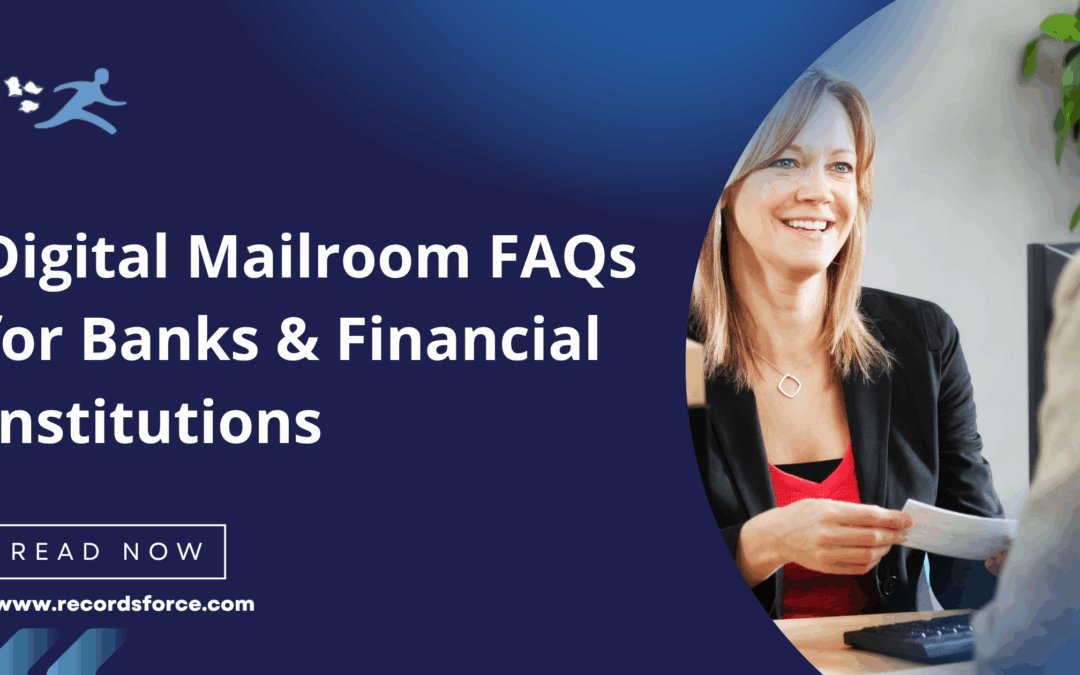Banks, credit unions, lending companies, and other financial institutions process significant volumes of daily mail, such as loan applications, customer identity documents, compliance notices, payment stubs, legal correspondence, and more. Handling this mail manually slows workflows, increases operational risk, and places unnecessary strain on teams. A digital mailroom solves these issues by securely converting incoming physical mail into digital documents and routing them instantly to the appropriate department or workflow.
If your financial institution is exploring a digital mailroom solution, you likely have questions. Below are the most frequently asked questions from banks and financial service providers, along with detailed answers.
1. What is a digital mailroom for financial institutions?
A digital mailroom for financial institutions is a secure outsourced service that receives your physical mail, opens it in a controlled environment, digitizes each item using high-speed scanning technology, extracts the required data, and delivers it to your teams electronically. Documents are routed to appropriate systems such as loan origination tools, underwriting workflows, customer service inboxes, records management systems, or compliance review platforms.
2. How does a digital mailroom improve operational efficiency in banking?
Financial mail is often tied to time-sensitive processes like loan decisions, KYC verification, regulatory responses, and customer inquiries. With a manual mailroom, documents may sit on desks or get misrouted, delaying service. A digital mailroom helps by:
- Reducing mail processing time from days to hours or even minutes
- Enabling faster loan decisions and account activations
- Helping ensure service-level agreement (SLA) compliance
- Supporting remote and geographically dispersed teams
- Reducing staffing burdens for internal scanning or sorting
- Providing real-time visibility and tracking of documents
- Standardizing document handling across branches or regional offices
3. How secure is a digital mailroom solution?
Security is a top concern in the financial services sector, especially when dealing with personally identifiable information (PII), financial statements, and regulatory documentation. Trusted digital mailroom providers operate within highly secure environments that include:
- SSAE-18 SOC II audited facilities
- Controlled building access with 24/7 surveillance
- Background-checked employees
- Strict chain-of-custody protocols
- Role-based access control and audit trails
- Encrypted digital delivery, both in transit and at rest
In many cases, outsourcing mail processing to a certified facility provides stronger security controls than in-house mail management.
4. What types of financial documents can a digital mailroom handle?
A digital mailroom can process virtually all incoming physical documents, including:
- Loan and mortgage applications
- Payment remittances and check stubs
- Customer correspondence
- Compliance-related documents and legal notifications
- Account opening forms
- Branch-level correspondence
- Credit and lending documentation
- Investor or regulatory communications
Digitized documents can be routed to users, departments, or directly into systems for automated processing.
5. How are documents routed after scanning?
Once scanned and indexed, documents are delivered based on pre-defined routing rules. For example:
- Mortgage applications may be routed into a loan origination system or team
- Customer service letters may be allocated to an assigned representative
- Payment documents may be forwarded to accounts receivable processing systems
- Legal correspondence may be flagged for immediate response
Delivery options include secure file transfers (SFTP), direct uploads into document management systems, workflow automation platforms, or integrations with financial software.
6. Can a digital mailroom support remote and hybrid banking teams?
Yes. One of the primary benefits of digitizing mail is the ability for employees to securely access time-sensitive documents from anywhere. Whether your teams are in-branch, working from a centralized hub, or operating remotely, they can receive, review, and process digitized mail immediately without waiting for physical delivery.
7. How does a digital mailroom support regulatory compliance?
Compliance is a major concern in financial services, with requirements from GLBA, FINRA, SEC, CFPB, and other regulatory bodies. A digital mailroom helps support compliance by:
- Maintaining a full audit trail of every document
- Ensuring consistent chain-of-custody tracking
- Making documents easily searchable and retrievable for audits
- Supporting retention and archiving policies
- Reducing the risk of lost or mishandled documentation
- Enabling faster responses to compliance inquiries or disputes
8. What is the typical turnaround time for digitized mail?
Most financial institutions receive processed digital mail within one business day of it being received.
9. What impact does a digital mailroom have on customer experience?
Speed and responsiveness are critical in customer-facing financial processes. Digital mailrooms accelerate decision-making and reduce backlogs, enabling banks to respond more quickly to customer applications, questions, or disputes. Faster mail processing leads to shorter loan approval cycles, quicker customer onboarding, and stronger client satisfaction.
10. What does implementation look like?
Implementation typically includes:
- Redirecting mail to the provider’s secure facility via mail forwarding or PO box changes
- Establishing indexing and routing rules
- Integrating scanned outputs with existing financial systems or workflows
- Testing and validation of routing accuracy
- Launching full production with ongoing monitoring
Is your financial institution ready to modernize mail handling?
By transitioning from a traditional mailroom to a digital one, financial institutions can dramatically improve efficiency, accelerate decision-making, reduce compliance risk, and support hybrid work environments without compromising security.
If your bank still relies on manual sorting and physical mail handling, now is the time to evaluate a digital approach.
Interested in learning how a digital mailroom can align with your financial workflows?
Contact us for a customized demonstration tailored to your institution’s needs.

